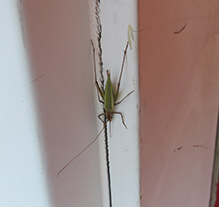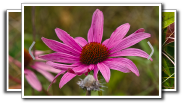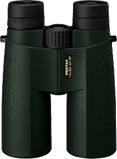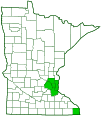Pine tree cricket
(Oecanthus pini)
Conservation • Description • Habitat • Ecology • Distribution • Taxonomy
Conservation Status |
|||
| IUCN Red List | not listed |
||
| NatureServe | NNR - Unranked |
||
| Minnesota | not listed |
||
Description
Pine tree cricket is a common singing insect. It occurs in the United States from Maine to northern Florida, west to eastern Minnesota and eastern Texas. It also occurs in southern Quebec and Ontario Canada.
As the common name suggests, pine tree crickets are usually found in the foliage of or very near pine trees, especially white pine, but they have also been recorded on balsam fir, black spruce, blue spruce, eastern redcedar, hemlock, juniper, tamarack, and yew. They are seldom seen because they usually live only in the upper branches of pine trees. Their green forewings and brown heads serve as an excellent camouflage when they rest among the pine needles and their bundle sheaves.
Adults are active from July through September in Minnesota. They are omnivorous. They feed mostly on plant matter, including leaves, fruits, and flowers, but they also feed on smaller soft-bodied insects and other invertebrates, and on insect eggs.
Adults are ⅝″ to 11⁄16″ (16 to 18 mm) in length, which is small for an orthopteran but medium-sized and robust for an Oecanthus. The body is long, slender and rather stout.
There are 18 Oecanthus species in North America north of Mexico. They are very similar in appearance and are usually identified by the markings on the first and second antennal segments. A few exceptions can be identified partially by their coloration. On just two species, pine tree cricket (Oecanthus pini) and tamarack tree cricket (Oecanthus laricis), the head and pronotum are reddish brown and the wing covers are green. Tamarack tree cricket only inhabits tamarack and hemlock, and it does not occur in Minnesota.
The head is uniformly light reddish brown. The antennae are mostly dull brown. The first two segments are pale brown with two black lines on each. The first segment does not have a swelling on the front and inner side. There is a long line on the inner edge, and near the end there is a short, slightly oblique line. The lines are broad, but they seldom merge, and they are usually weak and partially obscured. The second segment has two parallel lines.
The plate on the upper side of the first segment of the thorax (pronotum) is light reddish brown with a pale longitudinal stripe on each side.
The legs are olive brown. On the hind legs, the third segment (femur) is slender, not strongly enlarged near the base. The fourth segment (tibia) has several long spurs and many short spines on the outer (distal) half.
The leathery front wings (tegmina) on the male are translucent, flat, and rigid. They are much wider than the abdomen, and the tips are broadly rounded. The veins are bright green. On the female, the tegmina are narrower, membranous, and held tightly wrapped about the body. The veins are green.
The abdomen is greenish brown above and dull brown on the sides. On the female, the ovipositor is dark brown with a black tip.
Size
Total length: ⅝″ to 11⁄16″ (16 to 18 mm)
Song
The song is a continuous, soft trill consisting of 45 pulses per second at 3.5 kHz at 77° F (25° C).
Similar Species
Habitat
Ecology
Season
July through September
Behavior
Life Cycle
Nymph Food
Adult Food
Tree leaves, fruits, and flowers, small soft-bodied insects and other invertebrates, and insect eggs
Distribution |
||
|
Sources |
|
| 10/26/2025 | ||
Occurrence |
||
|
||
Taxonomy
Order
Orthoptera (grasshoppers, crickets, and katydids)
Suborder
Ensifera (katydids, crickets, and allies)
Infraorder
Gryllidea (crickets)
Superfamily
Grylloidea (true crickets and allies)
Family
Oecanthidae (tree crickets and bush crickets)
Subfamily
Oecanthinae (tree crickets)
Supertribe
Oecanthidi
Tribe
Oecanthini
Genus
Oecanthus
Subordinate Taxa
Synonyms
Common Names
pine tree cricket
Glossary
Femur
On insects and arachnids, the third, largest, most robust segment of the leg, coming immediately before the tibia. On humans, the thigh bone.
Pronotum
The exoskeletal plate on the upper side of the first segment of the thorax of an insect.
Tibia
The fourth segment of an insect leg, after the femur and before the tarsus (foot). The fifth segment of a spider leg or palp. Plural: tibiae.
Visitor Photos
Share your photo of this insect.
This button not working for you?
Simply email us at info@MinnesotaSeasons.com.
Attach one or more photos and, if you like, a caption.
Nancy Lundquist |

|
Seen in Wisconsin Rapids this weekend What is it and thank you. The tiny critters fascinate me. |
MinnesotaSeasons.com Photos
|

Slideshows

Visitor Videos
Share your video of this insect.
This button not working for you?
Simply email us at info@MinnesotaSeasons.com.
Attach a video, a YouTube link, or a cloud storage link.
Other Videos
Singing male Pine Tree Cricket
Nancy C

Visitor Sightings
Report a sighting of this insect.
This button not working for you?
Simply email us at info@MinnesotaSeasons.com.
Be sure to include a location.
MinnesotaSeasons.com Sightings


